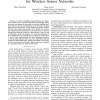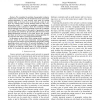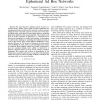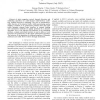INFOCOM
2008
IEEE
14 years 6 months ago
2008
IEEE
Abstract—To achieve scalability, energy-efficiency, and timeliness, wireless sensor network deployments increasingly employ in-network processing. In this paper, we identify sin...
INFOCOM
2008
IEEE
14 years 6 months ago
2008
IEEE
—Due to adverse aqueous environments, non-negligible node mobility and large network scale, localization for large-scale mobile underwater sensor networks is very challenging. In...
INFOCOM
2008
IEEE
14 years 6 months ago
2008
IEEE
INFOCOM
2008
IEEE
14 years 6 months ago
2008
IEEE
—We reconsider the problem of geographic routing in wireless ad hoc networks. We are interested in local, memoryless routing algorithms, i.e. each network node bases its routing ...
INFOCOM
2008
IEEE
14 years 6 months ago
2008
IEEE
—We argue that the traditional notion of trust as a relation among entities, while useful, becomes insufficient for emerging data-centric mobile ad hoc networks. In these system...
INFOCOM
2008
IEEE
14 years 6 months ago
2008
IEEE
Average consensus and gossip algorithms have recently received significant attention, mainly because they constitute simple and robust algorithms for distributed information proc...
INFOCOM
2008
IEEE
14 years 6 months ago
2008
IEEE
—We report that human walks performed in outdoor settings of tens of kilometers resemble a truncated form of Levy walks commonly observed in animals such as monkeys, birds and ja...
INFOCOM
2008
IEEE
14 years 6 months ago
2008
IEEE
—A joint congestion control, channel allocation and scheduling algorithm for multi-channel multi-interface multihop wireless networks is discussed. The goal of maximizing a utili...
INFOCOM
2008
IEEE
14 years 6 months ago
2008
IEEE
— In this paper we study the problem of jointly performing scheduling and congestion control in mobile adhoc networks so that network queues remain bounded and the resulting flo...
INFOCOM
2008
IEEE
14 years 6 months ago
2008
IEEE
—In the absence of end-to-end quality of service (QoS), overlay routing has been used as an alternative to the default best effort Internet routing. Using end-to-end network meas...




